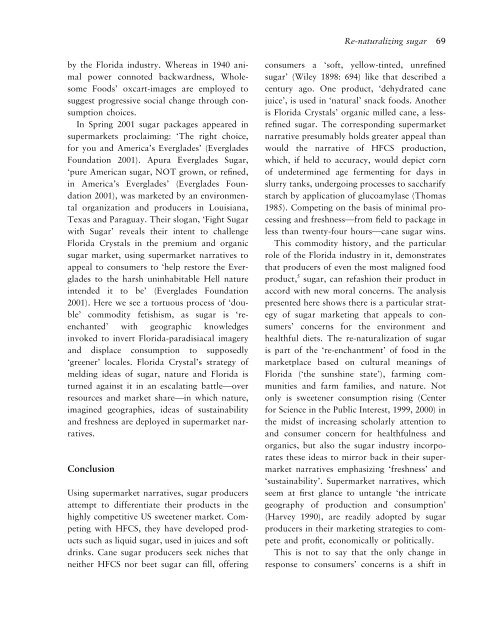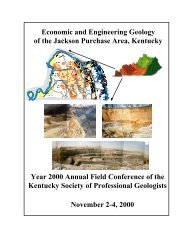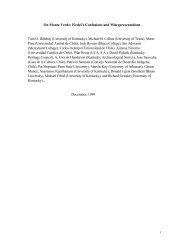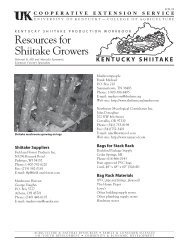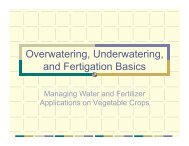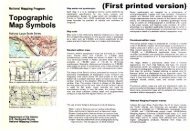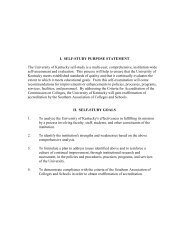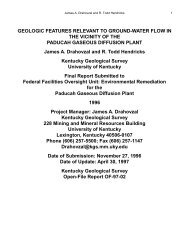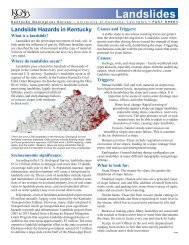Re-naturalizing sugar: narratives of place, production and ...
Re-naturalizing sugar: narratives of place, production and ...
Re-naturalizing sugar: narratives of place, production and ...
You also want an ePaper? Increase the reach of your titles
YUMPU automatically turns print PDFs into web optimized ePapers that Google loves.
y the Florida industry. Whereas in 1940 animal<br />
power connoted backwardness, Wholesome<br />
Foods’ oxcart-images are employed to<br />
suggest progressive social change through consumption<br />
choices.<br />
In Spring 2001 <strong>sugar</strong> packages appeared in<br />
supermarkets proclaiming: ‘The right choice,<br />
for you <strong>and</strong> America’s Everglades’ (Everglades<br />
Foundation 2001). Apura Everglades Sugar,<br />
‘pure American <strong>sugar</strong>, NOT grown, or refined,<br />
in America’s Everglades’ (Everglades Foundation<br />
2001), was marketed by an environmental<br />
organization <strong>and</strong> producers in Louisiana,<br />
Texas <strong>and</strong> Paraguay. Their slogan, ‘Fight Sugar<br />
with Sugar’ reveals their intent to challenge<br />
Florida Crystals in the premium <strong>and</strong> organic<br />
<strong>sugar</strong> market, using supermarket <strong>narratives</strong> to<br />
appeal to consumers to ‘help restore the Everglades<br />
to the harsh uninhabitable Hell nature<br />
intended it to be’ (Everglades Foundation<br />
2001). Here we see a tortuous process <strong>of</strong> ‘double’<br />
commodity fetishism, as <strong>sugar</strong> is ‘reenchanted’<br />
with geographic knowledges<br />
invoked to invert Florida-paradisiacal imagery<br />
<strong>and</strong> dis<strong>place</strong> consumption to supposedly<br />
‘greener’ locales. Florida Crystal’s strategy <strong>of</strong><br />
melding ideas <strong>of</strong> <strong>sugar</strong>, nature <strong>and</strong> Florida is<br />
turned against it in an escalating battle—over<br />
resources <strong>and</strong> market share—in which nature,<br />
imagined geographies, ideas <strong>of</strong> sustainability<br />
<strong>and</strong> freshness are deployed in supermarket <strong>narratives</strong>.<br />
Conclusion<br />
Using supermarket <strong>narratives</strong>, <strong>sugar</strong> producers<br />
attempt to differentiate their products in the<br />
highly competitive US sweetener market. Competing<br />
with HFCS, they have developed products<br />
such as liquid <strong>sugar</strong>, used in juices <strong>and</strong> s<strong>of</strong>t<br />
drinks. Cane <strong>sugar</strong> producers seek niches that<br />
neither HFCS nor beet <strong>sugar</strong> can fill, <strong>of</strong>fering<br />
<strong>Re</strong>-<strong>naturalizing</strong> <strong>sugar</strong> 69<br />
consumers a ‘s<strong>of</strong>t, yellow-tinted, unrefined<br />
<strong>sugar</strong>’ (Wiley 1898: 694) like that described a<br />
century ago. One product, ‘dehydrated cane<br />
juice’, is used in ‘natural’ snack foods. Another<br />
is Florida Crystals’ organic milled cane, a lessrefined<br />
<strong>sugar</strong>. The corresponding supermarket<br />
narrative presumably holds greater appeal than<br />
would the narrative <strong>of</strong> HFCS <strong>production</strong>,<br />
which, if held to accuracy, would depict corn<br />
<strong>of</strong> undetermined age fermenting for days in<br />
slurry tanks, undergoing processes to saccharify<br />
starch by application <strong>of</strong> glucoamylase (Thomas<br />
1985). Competing on the basis <strong>of</strong> minimal processing<br />
<strong>and</strong> freshness—from field to package in<br />
less than twenty-four hours—cane <strong>sugar</strong> wins.<br />
This commodity history, <strong>and</strong> the particular<br />
role <strong>of</strong> the Florida industry in it, demonstrates<br />
that producers <strong>of</strong> even the most maligned food<br />
product, 5 <strong>sugar</strong>, can refashion their product in<br />
accord with new moral concerns. The analysis<br />
presented here shows there is a particular strategy<br />
<strong>of</strong> <strong>sugar</strong> marketing that appeals to consumers’<br />
concerns for the environment <strong>and</strong><br />
healthful diets. The re-naturalization <strong>of</strong> <strong>sugar</strong><br />
is part <strong>of</strong> the ‘re-enchantment’ <strong>of</strong> food in the<br />
market<strong>place</strong> based on cultural meanings <strong>of</strong><br />
Florida (‘the sunshine state’), farming communities<br />
<strong>and</strong> farm families, <strong>and</strong> nature. Not<br />
only is sweetener consumption rising (Center<br />
for Science in the Public Interest, 1999, 2000) in<br />
the midst <strong>of</strong> increasing scholarly attention to<br />
<strong>and</strong> consumer concern for healthfulness <strong>and</strong><br />
organics, but also the <strong>sugar</strong> industry incorporates<br />
these ideas to mirror back in their supermarket<br />
<strong>narratives</strong> emphasizing ‘freshness’ <strong>and</strong><br />
‘sustainability’. Supermarket <strong>narratives</strong>, which<br />
seem at first glance to untangle ‘the intricate<br />
geography <strong>of</strong> <strong>production</strong> <strong>and</strong> consumption’<br />
(Harvey 1990), are readily adopted by <strong>sugar</strong><br />
producers in their marketing strategies to compete<br />
<strong>and</strong> pr<strong>of</strong>it, economically or politically.<br />
This is not to say that the only change in<br />
response to consumers’ concerns is a shift in


